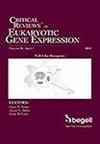Fundamentals and translational applications of stem cells and biomaterials in dental, oral and craniofacial regenerative medicine
IF 1.5
4区 医学
Q4 BIOTECHNOLOGY & APPLIED MICROBIOLOGY
Critical Reviews in Eukaryotic Gene Expression
Pub Date : 2024-04-01
DOI:10.1615/critreveukaryotgeneexpr.2024053036
引用次数: 0
Abstract
Regenerative dental medicine continuously expands to improve treatments for prevalent clinical problems in dental and oral medicine. Stem cell based translational opportunities include regenerative therapies for tooth restoration, root canal therapy and inflammatory processes (e.g., periodontitis). The potential of regenerative approaches relies on the biological properties of dental stem cells. These and other multipotent somatic mesenchymal stem cell (MSC) types can in principle be applied as either autologous or allogeneic sources in dental procedures. Dental stem cells have distinct developmental origins and biological markers that determine their translational utility. Dental regenerative medicine is supported by mechanistic knowledge of the molecular pathways that regulate dental stem cell growth and differentiation. Cell fate determination and lineage progression of dental stem cells is regulated by multiple cell signaling pathways (e.g., WNTs, BMPs) and epigenetic mechanisms, including DNA modifications, histone modifications, and non-coding RNAs (e.g., miRNAs and lncRNAs). This review also considers a broad range of novel approaches in which stem cells are applied in combination with biopolymers, ceramics and composite materials, as well as small molecules (agonistic or anti-agonistic ligands) and natural compounds. Promising concepts in bone and dental tissue engineering continue to drive innovation in dental and non-dental restorative procedures.干细胞和生物材料在牙科、口腔和颅面再生医学中的基础和转化应用
再生牙科医学不断发展,以改善牙科和口腔医学中普遍存在的临床问题的治疗方法。以干细胞为基础的转化机会包括牙齿修复、根管治疗和炎症过程(如牙周炎)的再生疗法。再生方法的潜力取决于牙科干细胞的生物特性。这些干细胞和其他多能体细胞间充质干细胞(MSC)类型原则上可作为自体或异体来源应用于牙科手术。牙科干细胞具有不同的发育起源和生物标记,这决定了它们的转化用途。牙科再生医学得到了调控牙科干细胞生长和分化的分子途径的机理知识的支持。牙科干细胞的细胞命运决定和品系进展受多种细胞信号通路(如WNTs、BMPs)和表观遗传机制调控,包括DNA修饰、组蛋白修饰和非编码RNA(如miRNAs和lncRNAs)。本综述还考虑了干细胞与生物聚合物、陶瓷和复合材料以及小分子(激动或抗拮抗配体)和天然化合物结合应用的各种新方法。骨和牙科组织工程中前景广阔的概念将继续推动牙科和非牙科修复程序的创新。
本文章由计算机程序翻译,如有差异,请以英文原文为准。
求助全文
约1分钟内获得全文
求助全文
来源期刊

Critical Reviews in Eukaryotic Gene Expression
生物-生物工程与应用微生物
CiteScore
2.70
自引率
0.00%
发文量
67
审稿时长
1 months
期刊介绍:
Critical ReviewsTM in Eukaryotic Gene Expression presents timely concepts and experimental approaches that are contributing to rapid advances in our mechanistic understanding of gene regulation, organization, and structure within the contexts of biological control and the diagnosis/treatment of disease. The journal provides in-depth critical reviews, on well-defined topics of immediate interest, written by recognized specialists in the field. Extensive literature citations provide a comprehensive information resource.
Reviews are developed from an historical perspective and suggest directions that can be anticipated. Strengths as well as limitations of methodologies and experimental strategies are considered.
 求助内容:
求助内容: 应助结果提醒方式:
应助结果提醒方式:


